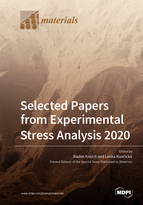Selected Papers from Experimental Stress Analysis 2020
A special issue of Materials (ISSN 1996-1944). This special issue belongs to the section "Manufacturing Processes and Systems".
Deadline for manuscript submissions: closed (31 December 2020) | Viewed by 30035
Special Issue Editors
Interests: materials forming; severe plastic deformation; non-ferrous metals; composites; thermomechanical processing; numerical simulations
Special Issues, Collections and Topics in MDPI journals
Interests: thermo-mechanical treatment; non-ferrous metals; structure and stress analyses; numerical methods
Special Issues, Collections and Topics in MDPI journals
Special Issue Information
Dear Colleagues,
The Experimental Stress Analysis 2020 is organized with the support of Czech Society for Mechanics, Expert Group of Experimental Mechanics, and will be held in Sobotin, Czech Republic, 19–22 October 2020. This international conference is mainly focused on sharing professional experience and discussing new theoretical and practical findings. The objective of the conference is to identify the current situation, exchange experiences, and establish and strengthen relationships between universities, companies, and scientists from the field of experimental mechanics in mechanical and civil engineering.
The topics of the conference include experimental research on materials and structures subjected to mechanical, thermal–mechanical, or dynamic loading, including damage, fatigue, and fracture analysis. Special attention shall be paid to advances in optical methods and other nondestructive testing techniques (DIC, DIV, ESPI, photoelasticity, X-ray and neutron diffraction, etc.) and sensor technology (strain gages, optical fiber applications, accelerometers, etc.). The importance of modern experimental technique application in research and developments of nanomaterials, nanostructures, composites, smart materials, and structures and materials for additive manufacturing will be addressed during the conference.
This Special Issue will select excellent papers from Experimental Stress Analysis 2020. Original research articles, as well as review articles, are welcome in this Special Issue. Potential topics include:
- Development of experimental methods in mechanics;
- Development of experimental methods in biomechanics;
- New methods and applications of deformation and stress analysis in mechanical structures;
- New methods and applications of deformation and stress analysis in civil and other structures;
- Experiment as a tool for the verification of analytical and numerical methods;
- Experimental research and prediction of strength, life and operational reliability of structures and devices;
- Monitoring of operational loadings and operational states of structures and devices;
- Mechanics of advanced materials, composites and additive manufacturing materials.
Assoc. Prof. Radim Kocich
Dr. Lenka Kunčická
Guest Editors
Manuscript Submission Information
Manuscripts should be submitted online at www.mdpi.com by registering and logging in to this website. Once you are registered, click here to go to the submission form. Manuscripts can be submitted until the deadline. All submissions that pass pre-check are peer-reviewed. Accepted papers will be published continuously in the journal (as soon as accepted) and will be listed together on the special issue website. Research articles, review articles as well as short communications are invited. For planned papers, a title and short abstract (about 100 words) can be sent to the Editorial Office for announcement on this website.
Submitted manuscripts should not have been published previously, nor be under consideration for publication elsewhere (except conference proceedings papers). All manuscripts are thoroughly refereed through a single-blind peer-review process. A guide for authors and other relevant information for submission of manuscripts is available on the Instructions for Authors page. Materials is an international peer-reviewed open access semimonthly journal published by MDPI.
Please visit the Instructions for Authors page before submitting a manuscript. The Article Processing Charge (APC) for publication in this open access journal is 2600 CHF (Swiss Francs). Submitted papers should be well formatted and use good English. Authors may use MDPI's English editing service prior to publication or during author revisions.
Keywords
- Mechanical properties
- Functional properties
- Metallic systems
- Mechanical processing
- Structural phenomena







